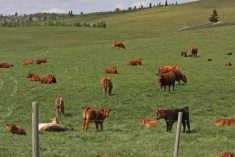GLEN EWEN, Sask. – It may be the lazy days of summer for some, but not for a family from southeastern Saskatchewan.
George and Susan Taylor operate a pre-pick and U-pick strawberry business on their mixed farm south of Glen Ewen.
During the berry picking season, the Taylors’ already busy schedule shifts into overdrive.
Their summers have been hectic ones since 1991 when they decided to devote a few acres to strawberries.
“We were young and optimistic and wanted to diversify our farm without getting more land,” Susan said.
Read Also

Trump’s tariffs take their toll on U.S. producers
U.S. farmers say Trump’s tariffs have been devastating for growers in that country.
A friend from Portage la Prairie, Man., had a strawberry U-pick operation and gave them some start-up advice. Saskatchewan Water provided guidance on irrigation, how to prevent alkali, different types of soil and where the plants would do best on their farm.
“Having suitable soil with proper pH and nutrient levels is key to growing strawberries,” Susan said.
In the first year, the Taylors planted three acres of strawberries. The goal was to get the plants well established. Blossoms were picked off to divert the growing energy to the main plant. Much time was spent hoeing and pulling weeds, cultivating between rows and ensuring that plants received ample moisture.
The next summer, Taylor Strawberries opened as a U-pick.
“It was a family operation then, but almost every year, we’ve hired students from the community,” Susan said.
Due to the good demand for strawberries, the Taylors increased the size of their business in 1998, eventually reaching 15 acres in production. They travelled to different towns to sell the berries and had a booth at the farmers’ market in Estevan.
Many people drove to the farm to pick their own berries and staff was there to help them.
The family was pleased with the interest in their product, but the expansion required additional employees.
There were extra costs associated with travel and unsold product had to be packaged and placed in freezers each night.
Their financial statement told the story. They were selling more, but their overall profit remained much the same. They decided to downsize to today’s more manageable five acres.
The Taylors’ eight children play a major role on the strawberry farm.
Joanna, Matthew, Janet, Loralee, April, Jeremy, Aaron and Joel range in age from nine to 26, and all have planted, weeded and picked strawberries, assembled the four litre cardboard baskets and directed people to the patch.
George has an off-farm job as a welder, but takes time off to help during the strawberry season.
“That’s something we really appreciate,” said George. “My boss knows how important the strawberry farm is to us.”
“To get all the orders filled they need to be picking berries by 8 a.m.,” Susan said.
“It’s hard work, but it’s given our children work experience and a chance to earn some money. They’ve interacted with people of all ages and learned business skills. I think it’s helped the older ones get jobs later on.”
“Hard work builds character,” George tells his children when their motivation to pick berries lags. He said they have learned to solve problem themselves and to challenge one another at picking time.
Susan has found it works best if people phone and arrange a time to pick berries. This ensures the customer that the U-pick is open and sufficient berries are ripe and available.
People who phone and order baskets are given a pickup time.
The Taylors have customers from neighbouring communities and beyond. One woman regularly places orders for 50 baskets, picks them up at the farm and delivers them to people in her town.
“Some people come and pick berries, and if they see some weeds in their row, they’ll even pull them for us,” Susan said.
The patch has been hailed out twice and suffered a large amount of winterkill one year.
For frost protection and during dry times, the Taylors use their irrigation system. However, timely rains are best.
Last season was a good year for the family. The weather was good for growing berries and they sold all they grew.
“We have sandy soil and it can handle a lot of water,” George said.
“This is the first year we didn’t have to irrigate in June. Usually we have to do that several times in the spring.”
The Taylors have not had any problems with birds or animals eating the fruit.
To protect the plants from winterkill, they are covered with straw prior to freezeup. In the spring, the straw is pushed off the plants and into the rows.
The straw helps keep weeds from growing, retains soil moisture, keeps the berries clean and provides a kneeling pad for berry pickers.
No pesticides or fungicides are used on the plants. To control weeds and grass, a new patch is planted every three to four years and the old patch is turned into summerfallow. The plants are ordered from a fruit growers association.
The strawberry season lasts from early July to freezeup. Fruit from the June bearing plants is generally ready from July to early August. The day neutral strawberries produce in spring and mid-August.
This year, the Taylors launched a small market garden to offer fresh vegetables and raspberries. To further diversify the farm, Susan sells horses.
Fruit facts
•2,000 acres of fruit are grown in Saskatchewan
•There are 200 to 300 growers in Saskatchewan
•Saskatoons are Saskatchewan’s largest fruit crop, followed by haskap, cherries and strawberries
–Saskatchewan Agriculture














